
|
|
Rearguard Action - the Drone Glow-Plug Conversion
One variant of the Drone diesel which was only briefly covered in the other article was the factory glow-plug conversion kit. At the time when I wrote my original Drone article for the late Ron Chernich's "Model Engine News" (MEN) website way back in early 2010, I didn't have access to an actual example of this variant. Good fortune has since placed such a unit in my hands, enabling me to finally complete my work on the Drone and its various renditions by conducting an actual test of the Drone in its factory glow-plug configuration. Although I don’t intend to repeat the Drone story in its entirety here, I feel that it's worthwhile to begin by summarizing the background to the development of the variant now under discussion. Those of you already in the know are cordially invited to skip ahead to the following sections of this article. Background
The Drone was arguably the most successful of all American diesels both in commercial and competition terms. Some 15,000 units were produced in total during those few years, a high figure for an American diesel. The engine was so well built and so durable that a substantial proportion of that total still survives today. The Drone diesel was produced in two quite distinct variants. Both used fixed compression and shared common bore and stroke measurements of 0.656 in. (16.67 mm) and 0.875 in. (22.22 mm) respectively, giving them a displacement of 4.85 cc (0.297 cuin.). These rather long-stroke measurements were well suited to the relatively low design operating speeds which the use of fixed compression pretty much dictated. The main bearing of the first model consisted of a bronze bushing incorporated into a housing formed integrally with the main crankcase, while the second model Drone featured a separate front housing with a single ball-race supporting the shaft at the rear. Both models utilized cross-flow loop scavenging with the exhaust stack discharging to the left (looking forward in the direction of flight). The cast iron piston was stepped on the transfer side to act as a deflector for incoming fuel mixture.
The first sign of challenging times ahead came in late 1947 with the introduction of the commercial miniature glow-plug by Ray Arden. By the end of that year engines equipped with the new form of ignition were already showing great promise. Leon Shulman felt that he had no choice other than to further develop the Drone diesel to meet the impending competition. The result of Leon’s thinking was the mid 1948 appearance of one of the all-time However, by mid 1948 the glow-plug takeover of American power modelling was well and truly underway. Although the Drone did achieve some success that year, winning the stunt competition at the Mirror Meet for the second straight year and also taking the radio control event at the same meeting, the writing on the wall was becoming increasingly easy to read. The December 1948 appearance of the Fox 35 in production form pretty much nailed down the coffin lid for diesels in America, at least for that time.
Oddly enough, complete engines were never sold with this head fitted - it remained an after-market accessory which the factory could supply upon request. Moreover, such heads were only available from the factory for the second model Drone. The late Bert Striegler had some direct hands-on experience with Drone Engineering’s variable compression head for the second model Drone. The contra piston was mounted in the head rather than in the bore. Bert commented that the factory head used a very short contra piston, leading to most of them leaking excessively. Bert fitted one of his own second model Drones with a variable compression head of his own design and construction. This head featured a brass contra piston which was fitted with a high temperature O-ring and was contained completely inside the head.
When I wrote the original Drone article for MEN in 2010, Allen Heinrich of Aerodyne was still selling both pre-mixed Drone fixed-compression diesel fuel and his own variable compression heads. The latter were constructed pretty much along the lines of that developed by Bert Streigler apart from the use of an aluminium contra-piston rather than a brass component. I fitted an Aerodyne head to one of my second model Drones, finding that it worked very well indeed, yielding a small but useful performance increase using conventional diesel fuel. The engine's peak output was raised to around 0.271 BHP @ 6,500 RPM. Lots of lovely low-end torque on tap! The engine's main bugbear was its vibration, which was becoming quite severe as 7,000 RPM was approached. As of late 1948, most Drone users had either made the switch from the first model to the second model Drone or had gone over to glow-plug operation. This user exodus left a whole bunch of first model Drones which had a lot of life left in them since they had only been in use for a year or less. Moreover, the Drone is a practically bullet-proof design, meaning that these "out-dated" engines remained in first class mechanical condition. Noting this situation and recognising the sweeping changes that were coming to the US model engine scene, Leon Shulman did some thinking about ways and means of extending the useful lives of these first model units. His solution was both obvious and appropriate - he decided to develop and produce an accessory glow-plug head for that model. The resulting Drone glow-plug variant forms the central subject of this article. The Drone Glow-Plug Head
It seems best to begin by stating for the record that the first model Drone was never sold as a purpose-built glow-plug unit. All of the examples encountered today, like my own unit, were originally diesel models which have been retro-fitted with the after-market conversion head sold separately by Drone Engineering. The conversion from diesel to glow-plug was a very simple matter of removing the diesel head and replacing it with the glow-plug component. A screwdriver was the only tool required. A further source of confusion arises from the fact that a fair number of second-model ball-bearing Drones were converted to glow-plug operation by their owners - a very simple operation indeed for anyone having access to a lathe. Indeed, a number of individuals reportedly offered conversion services for these engines to assist those who were not equipped to carry out the work themselves. Second-model Drones converted in this way still show up fairly regularly on eBay and elsewhere. This has led to a common belief that such heads were supplied by the factory for the ball-bearing Drone, or even that complete second-model engines were sold new as glow-plug units. However, according to the late Gus Munich, a long-time original Drone user and enthusiast who drew most of his information from direct long-term contact with his good friend Leon Shulman, the accessory glow head was only ever supplied by the The greatest benefit would have been the fact that the revised form of ignition would have accommodated any main bearing and conrod bearing wear. Such wear had the potential to affect the engine’s operational efficiency in fixed-compression diesel form by reducing its effective compression ratio. The genuine Drone factory glow heads were simply standard first model diesel heads with a centrally-tapped and smoothly contoured recess added to accept a standard long reach glow plug. Since the standard diesel head gave a compression ratio of 18:1, far too high for glow-plug operation, the modified heads also incorporated an internally-machined annular channel surrounding the glow plug hole in order to lower the compression ratio. The resulting combustion chamber configuration could scarcely have encouraged efficient combustion ..............but the engines did reportedly run reasonably well in this form. We’ll be testing that report later in this article. It seems highly likely that performance in glow-plug form would have been greatly enhanced by the use of a purpose-built head with a more efficient combustion chamber configuration. Presumably the decision to use converted fixed-compression diesel heads was economically driven. Unlike the gold-anodized diesel heads, the factory-converted glow-plug heads were not anodized, invariably being left in their plain aluminium finish after machining to distinguish them at a glance from the diesel components. The selling price of these heads was $2.25. There have been a few previous reports that such heads were also supplied in red, but Gus Munich confirmed directly through his discussions with Leon Shulman that this is incorrect - Leon stated categorically that only the plain finish was ever supplied by the factory. Any red-anodized heads are therefore the work of later owners or after-market suppliers. In-situ volumetric measurement of the glow-plug version's compression ratio is rendered rather difficult by the fact that the internal annular channel surrounding the glow plug installation hole traps air which has nowhere to go when the combusion chamber is filled with oil through the plug installation hole at top dead centre. Accurate measurement would require the removal of the head to physically measure its combustion chamber configuration and calculate the volume. I was not willing to disturb the excellent head seal on my "experienced" example to take such measurements. All that I can say is that my very experienced flicking finger tells me that the compression ratio is of the order of 7 to 1 - probably quite appropriate for the speeds at which the engine might be expected to operate. Apart from the wear issue noted earlier, another great advantage of operating the Drone on glow-plug ignition would have been the potential for achieving correct ignition timing at higher speeds than those for which the fixed diesel compression ratio was optimised. The use of fuels having different nitro contents plus the fitting of glow plugs having different heat ranges would have made this possible. However, a major issue here would have been the very heavy cast iron piston allied to the full disc crankweb with no counterbalance. Even in its relatively low-revving diesel form, the Drone is a bit of a vibration generator. At the higher speeds potentially possible with glow-plug ignition, I would expect this to be a limiting factor in the engine’s application. Such speculation is all very well, but there’s no substitute for actual operating experience. Just how well did the first model Drone perform in glow-plug guise? Let’s find out! The Drone Glow-Plug Variant on Test My writing of this article was greatly informed by my extensive previous operating experience with the various diesel versions of the Drone. I have retained complete records of numerous tests of this engine in pretty much all of its configurations. The key results are summarized in my companion article on the Drone diesel. They gave me a very solid basis for comparison. The particular glow-plug Drone which was available for test is a Mk. I plain bearing example bearing the serial number 7344. It is complete and original, with excellent running fits throughout. The only modification is the truing-up of the undersides of the beam mounting lugs by milling. This was a good move by a previous owner, since it allows the engine to be mounted very securely in a test stand or in a model. It has no effect upon performance.
My notes show that a good original first model Drone running on fixed compression using standard Drone all-ether diesel fuel delivers around 0.240 BHP @ 6,300 rpm. A 12x6 APC prop allows it to slightly exceed this speed on the bench. The greatest danger with glow-plug ignition is pre-ignition with heavy loads due to the very narrow speed range within which the engine’s timing will be optimal when leaned out. A full discusion of this issue will be found in my separate article on glow plug heat range selection. With glow-plug ignition, it’s always best to start running rich with a lighter load and come on down from there. For that reason, I decided to commence this test with a 10x6 APC prop, which the diesel version got up to 7,800 rpm while showing clear signs of under-compression and also exhibiting a problematic level of vibration. Depending on how things looked and felt with this load, I would progress to other props in whichever direction seemed appropriate. I would begin with the needle set very rich and proceed with caution towards the fully leaned-out condition. I would also use a low-nitro fuel to minimize the risk of pre-ignition. As received, the engine was fitted with a fully-functional classic O&R glow-plug which was probably its original equipment from 1948! I elected to use a far later Fox plug for the test, although I did plan to give the old O&R a run just for old time's sake. The fuel was a 5% nitro blend which was the mildest fuel that I had on hand at the time of the test. In all probability the 1948 users of the converted engine wouldn't have had access to anything stronger.
The first thing that I discovered was that the glow-converted Drone was almost absurdly easy to start! A heavy prime was not required - just a little fuel in the cylinder was all that it took. I also found that my usual "bounce-start" method for larger-displacement glows worked extremely well. You set the prop in the "ten past eight" position with the piston at bottom dead centre, prime, light the plug and HIT the prop backwards so that it "bounces" against compression. The inevitable backfire almost always starts the engine in the correct direction. I use this system on classic racing 60's with complete success and total safety. Using this method, the Drone proved to be a one-flick starter almost every time. Once running, the plug booster could be removed immediately, with no slowing down of the engine. This indicates that the compression ratio is adequate for the job. I had all the time in the world to fine-tune the needle setting. Going too lean merely caused the engine to slow down a little without stopping, making it very easy to find the sweet spot. Once that spot was found, running was completely smooth and mis-free. Suction seemed to be excellent - the engine handled the lowering level of fuel in the tank very well indeed, continuing to draw against a considerable negative fuel head as seen in the above photo. I was also extremely taken with the engine's exhaust note, which was unusually throaty, with a well-matched mix of overtones. Music to any engine fancier's ears ............
Indeed, further experimentation proved this to be the case. This was a really strange test, because I started from the far side of the peak and came downwards using progressively heavier loads to find the actual peak itself. Usually things go the other way round .............. this explains why there are so many data points at speeds above the peak. It turned out that the glow-plug version of the Drone came nowhere near matching its fixed-compression diesel sibling, at least on this fuel. The following data tell the story.
As the above data show, the Drone glow-plug conversion developed a peak output of around 0.138 BHP @ 6,500 rpm on the 5% nitro fuel used for this test. By way of comparison, my earlier test of Drone fixed compression diesel no. 441 found a peak output of around 0.240 BHP @ 6,300 rpm. It's simply no contest - the diesel wins hands-down! The two variants peak at very similar speeds, meaning that the diesel clearly out-torques the glow right across the speed range. While the diesel Drone does very well on an 11x10 prop, an 11x7 would suit the glow-plug variant far better.
I would guess that the resulting combination of point-source ignition, sequestered fuel mixture and very poor flame propagation characteristics would significantly delay the full involvement of the fresh charge in the combustion process following ignition. It's actually very hard to imagine a less efficient combustion chamber! I believe that this design shortcoming provides an adequate explanation for the performance shortfall measured during my tests. I'm certain that far better results would have been achieved by designing a new head from the ground up. Presumably the decision to simply adapt the diesel head was driven purely by economic considerations. It's true that the glow-plug Drone is a delightful engine to handle, running very smoothly and consistently at all times with that lovely exhaust note to entertain you. No doubt it would do measurably better on a higher-nitro fuel. However, by the time of its appearance as a commercial option, the levels of performance which the converted engine displayed during this test had already been greatly exceeded by other contemporary purpose-built 5 cc glow-plug engines. It's little wonder that this conversion doesn't seem to have done much to restore the dwindling fortunes of Drone Engineering! As a fitting conclusion to my test, I re-fitted the original O&R plug and gave the engine another run. The 72 year old plug worked perfectly and survived its moment of glory completely unscathed, living to fight another day if called upon in the future! Conclusion
It's an interesting observation that quite a few other manufacturers tried glow-plug conversions of their diesel models at one time or another. Len Steward (K Model Engineering Co.), Alan Allbon, Ted Martin (AMCO), Hefin Davies (D-C Ltd.), Basil Miles (E.D.), Charlie Gray (J.B.), Bert Judge (early FROG) and George Fletcher (later FROG) all tried such conversions. In every case, the glowplug version fell well short of matching the performance of the same model in diesel form. It took quite a while for the lesson to be learned that for best results a glow-plug motor has to be designed as such from the ground up, particularly when it comes to the combustion chamber. The glow-plug conversion of the Drone diesel serves as yet another confirmation of that basic truth. Still, a good try on the part of Leon Shulman! If you ever get a chance, give one a go - you'll enjoy doing so! That lovely exhaust note alone is well worth the price of admission! ___________________________________________ Article © Adrian C. Duncan, Coquitlam, British Columbia, Canada First published May 2022
|
||
| |
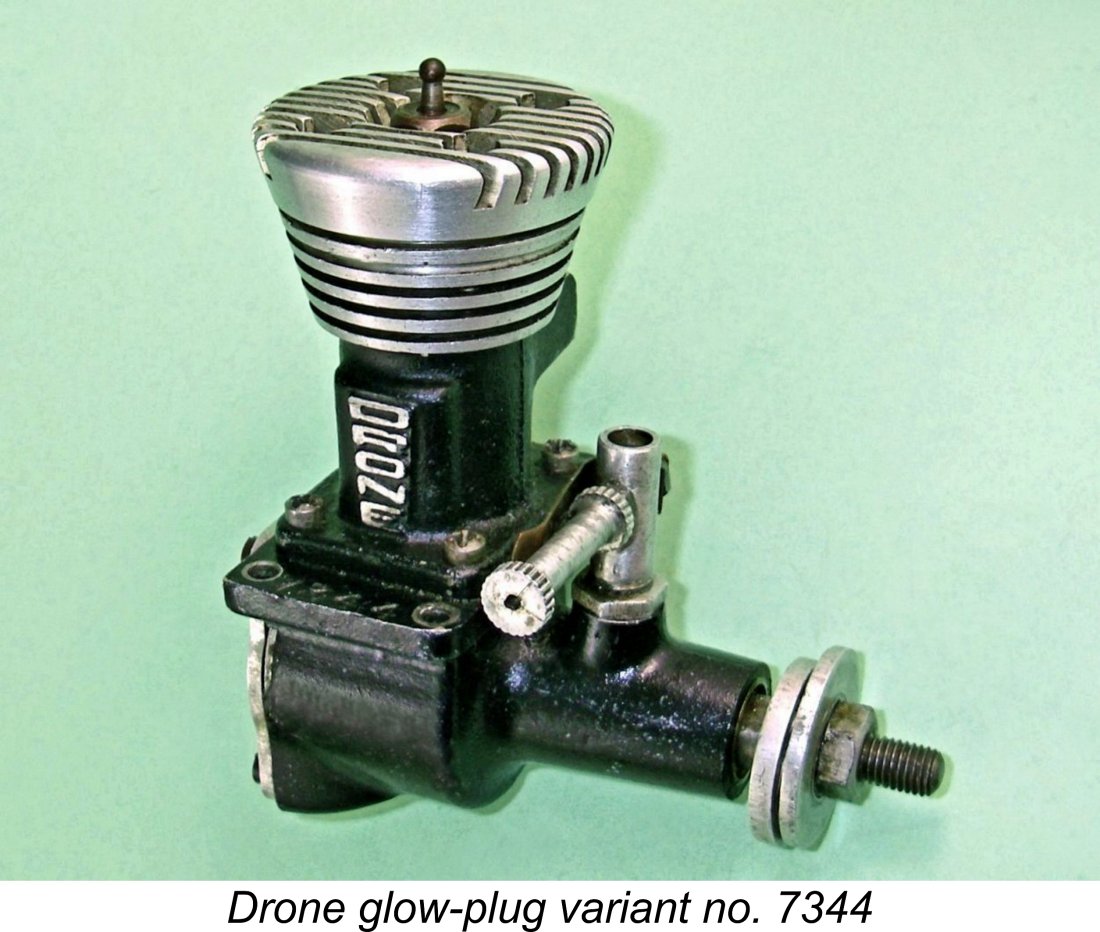 In a companion article to be found elsewhere on this website, I’ve traced the start-to-finish history of the famous
In a companion article to be found elsewhere on this website, I’ve traced the start-to-finish history of the famous 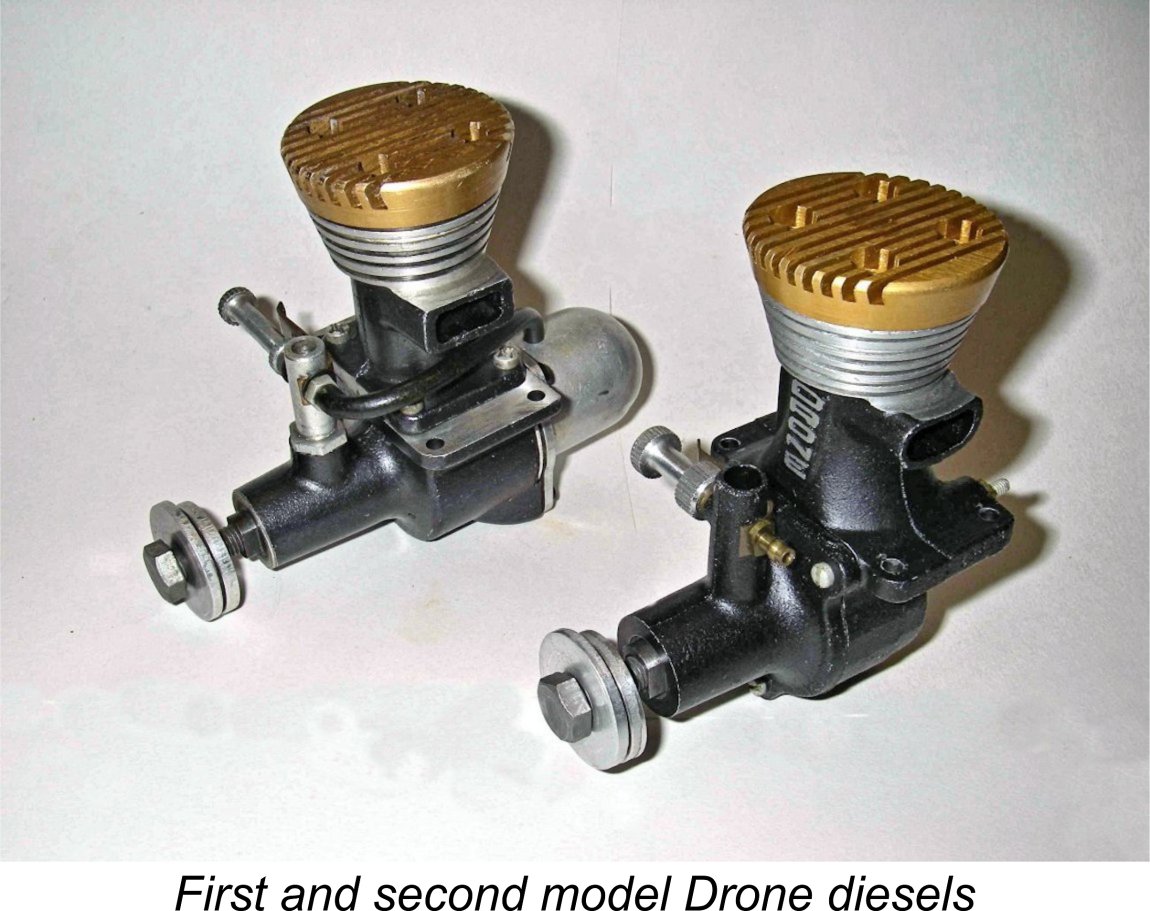 The Drone Diesel of 4.85cc (0.297 cu. in.) displacement was designed by the prominent American aeromodeller
The Drone Diesel of 4.85cc (0.297 cu. in.) displacement was designed by the prominent American aeromodeller 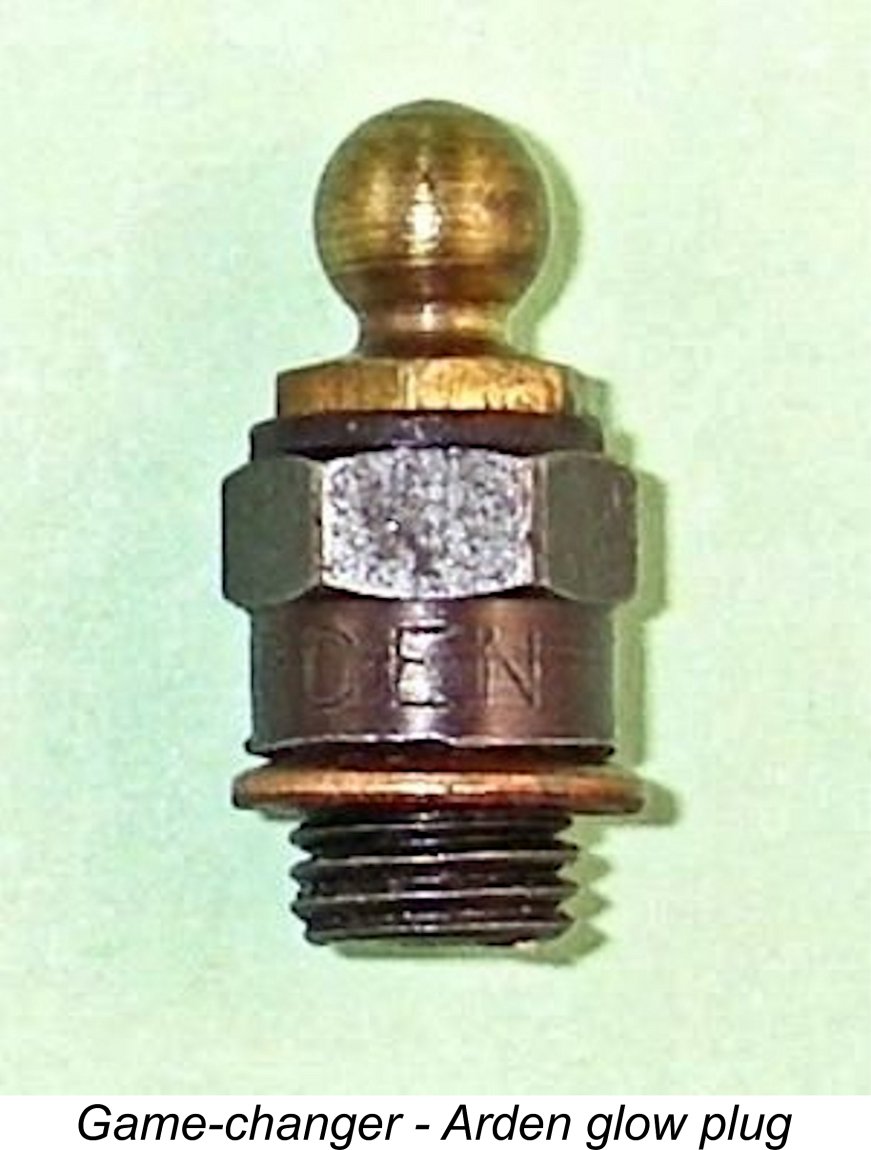 The first model Drone appeared in early 1947. It was quite actively promoted from the outset, hence drawing considerable attention from the contemporary modelling media. During 1947 the first model Drone achieved considerable competition success, particularly in the field of control-line stunt for which it was primarily designed. Users of the engine cleaned up at major stunt contests in America during that year. The 1947 US Nationals and the prestigious Mirror Meet both fell to the Drone, along with numerous other lesser contests. Around 10,000 examples were sold during the first 16 months of production.
The first model Drone appeared in early 1947. It was quite actively promoted from the outset, hence drawing considerable attention from the contemporary modelling media. During 1947 the first model Drone achieved considerable competition success, particularly in the field of control-line stunt for which it was primarily designed. Users of the engine cleaned up at major stunt contests in America during that year. The 1947 US Nationals and the prestigious Mirror Meet both fell to the Drone, along with numerous other lesser contests. Around 10,000 examples were sold during the first 16 months of production. 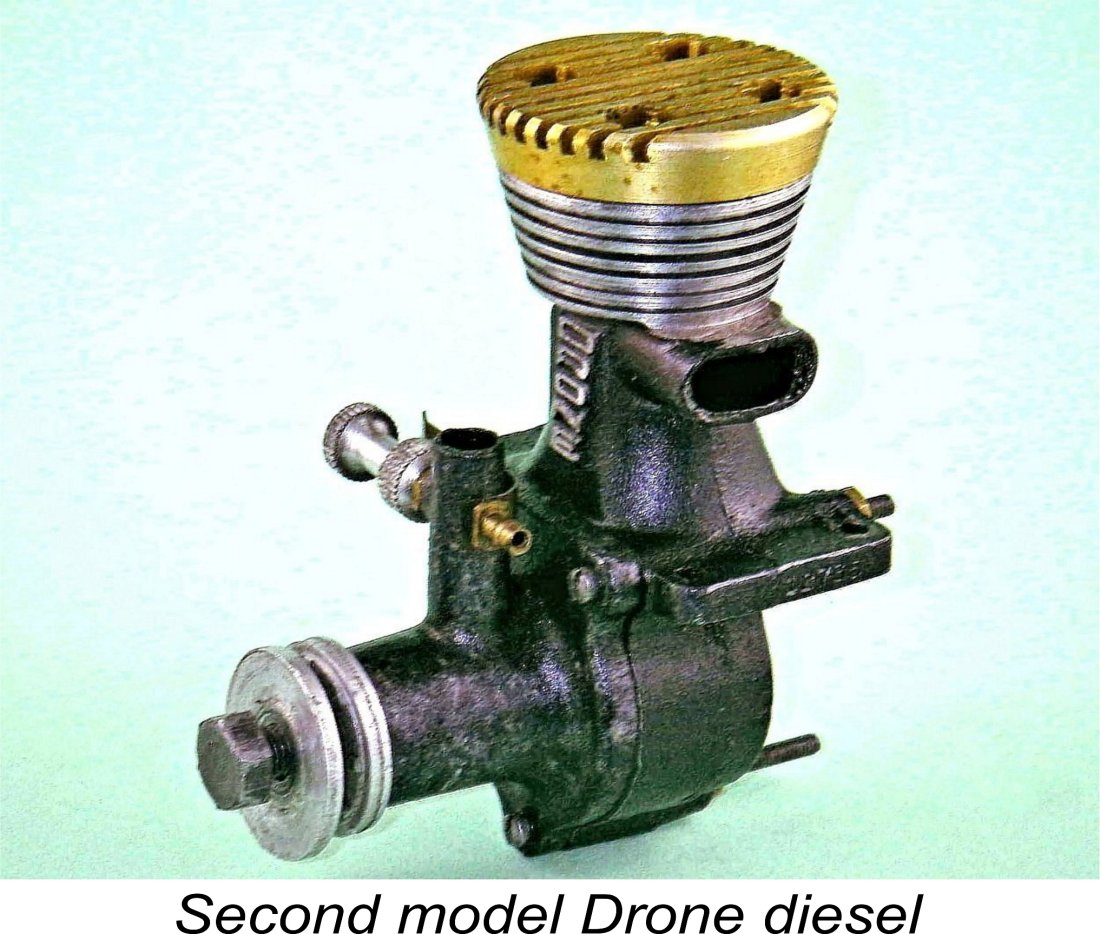
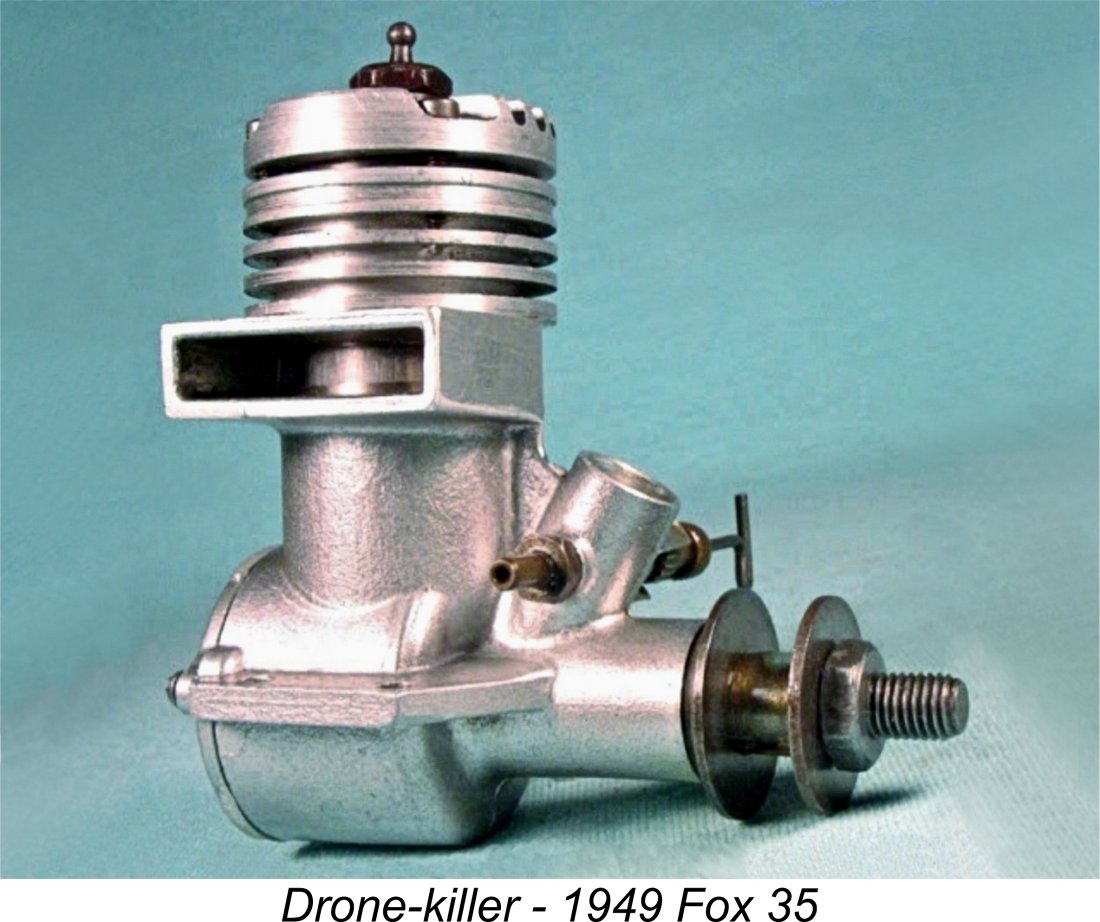
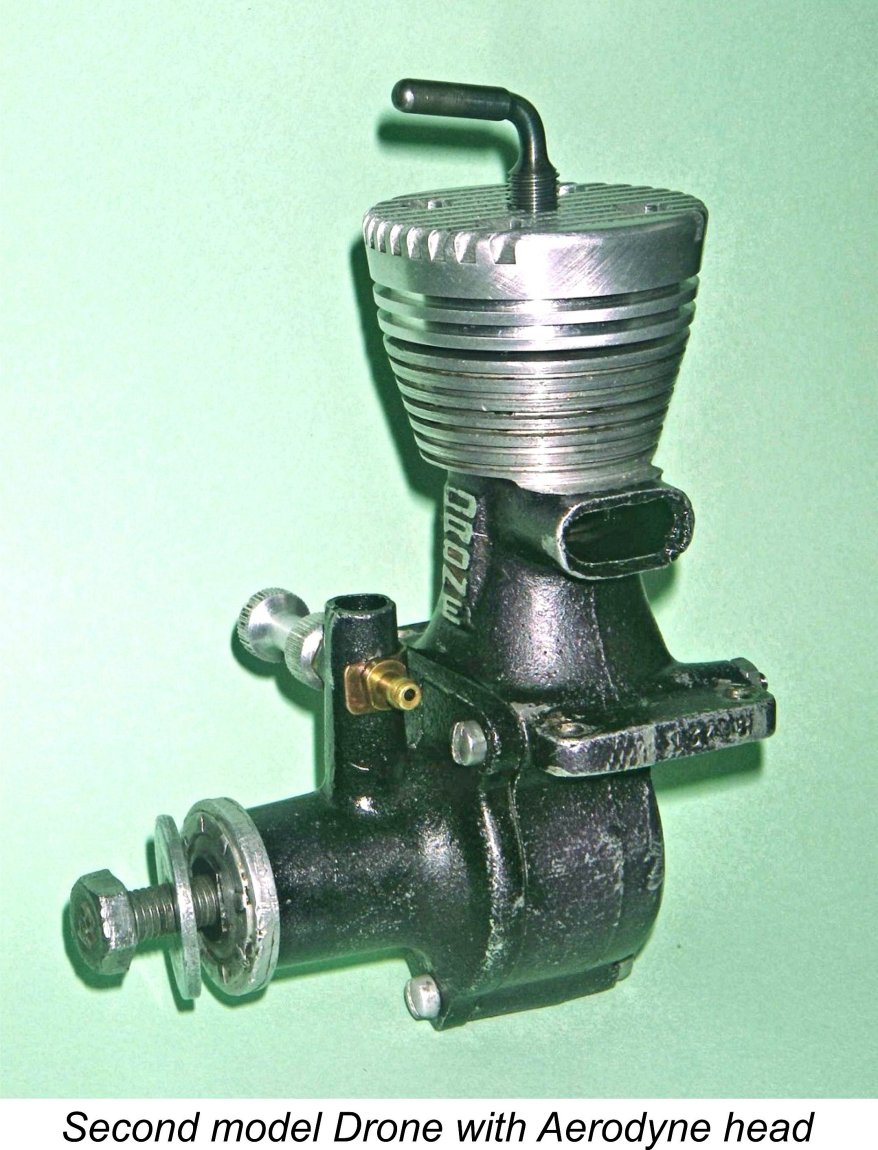 Bert’s tests of his head confirmed that the Drone now worked extremely well with standard diesel fuel mixes. Bert’s head did not leak and the compression control worked smoothly. Bert found starting even easier than with a fixed head. Overall, he felt that the performance of the engine was enhanced by this fitting, although he still agreed that a well set-up fixed-compression Drone was an easy starter and a strong runner.
Bert’s tests of his head confirmed that the Drone now worked extremely well with standard diesel fuel mixes. Bert’s head did not leak and the compression control worked smoothly. Bert found starting even easier than with a fixed head. Overall, he felt that the performance of the engine was enhanced by this fitting, although he still agreed that a well set-up fixed-compression Drone was an easy starter and a strong runner.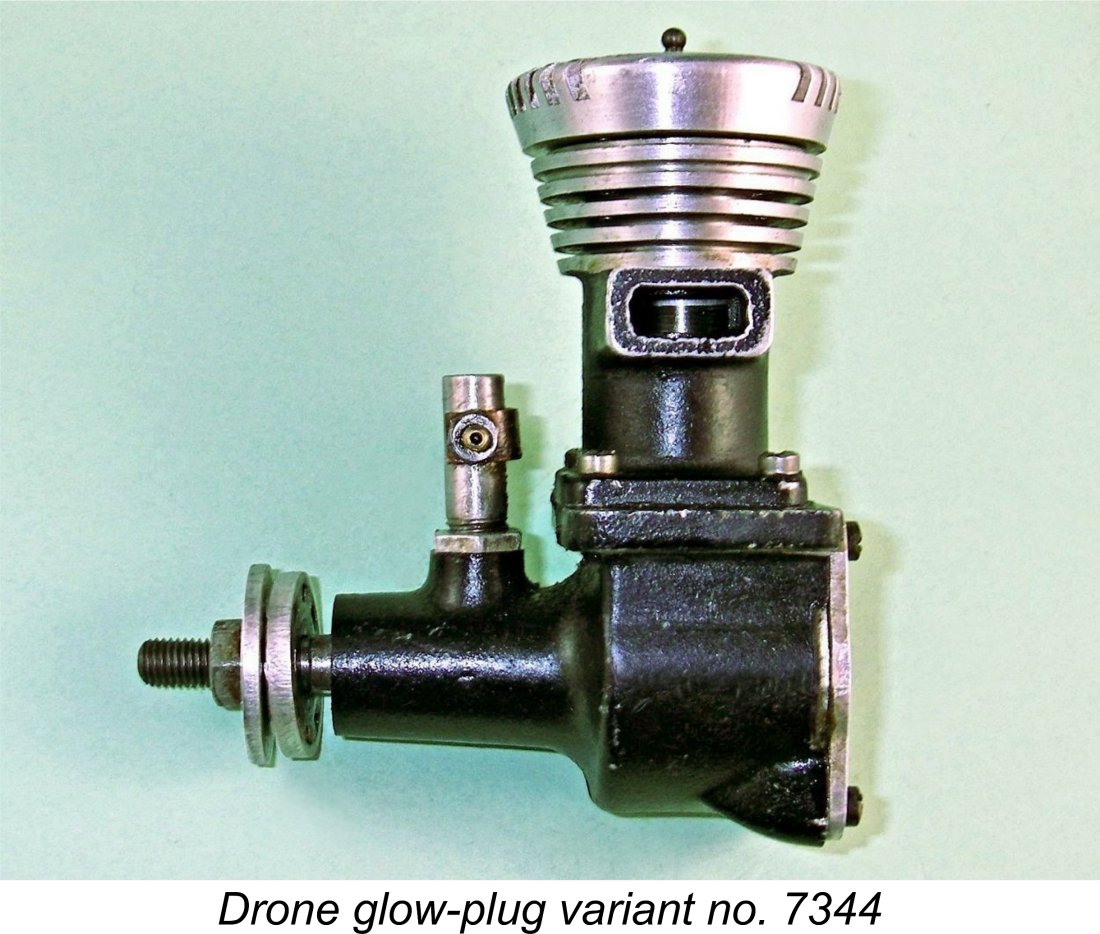 A fair bit of confusion surrounds the accessory glow heads supplied by Drone Engineering. One of my main objectives in writing this artticle was to dispel this confusion once and for all on the basis of authoritative information.
A fair bit of confusion surrounds the accessory glow heads supplied by Drone Engineering. One of my main objectives in writing this artticle was to dispel this confusion once and for all on the basis of authoritative information. 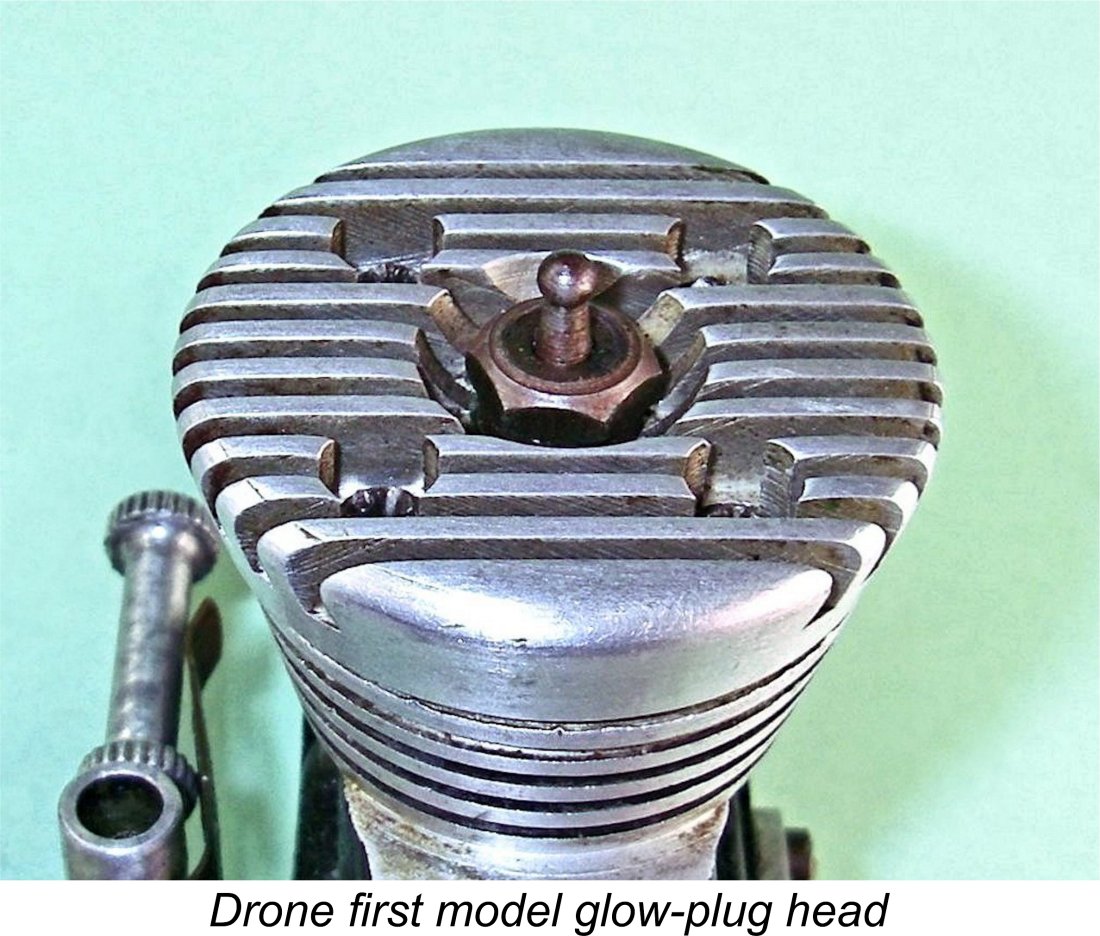 factory for the first model Drone. Leon’s intent was to provide owners of the then-redundant first model Drone diesel with an opportunity to breathe new life into their engines through the switch to glow-plug ignition.
factory for the first model Drone. Leon’s intent was to provide owners of the then-redundant first model Drone diesel with an opportunity to breathe new life into their engines through the switch to glow-plug ignition. 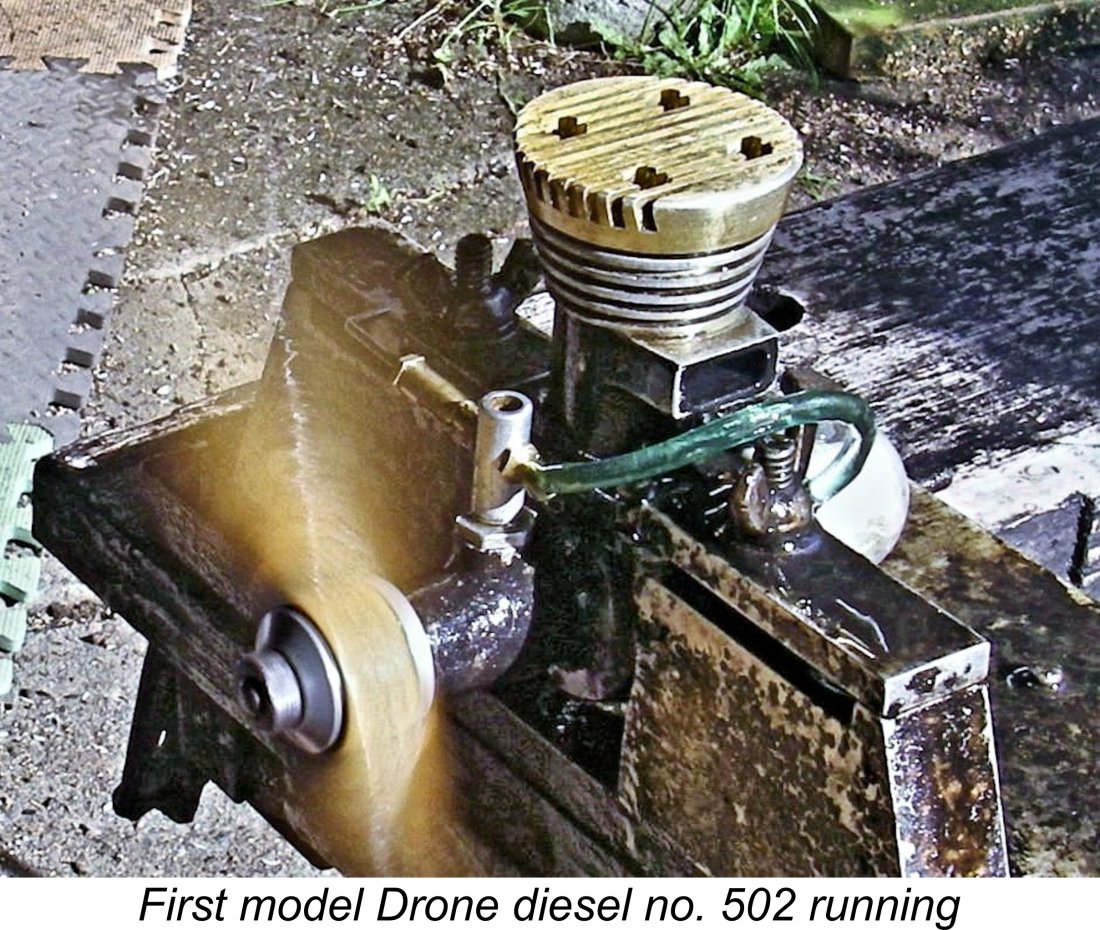 The engine has lost its tank, a fate which undoubtedly befell any first model Drone which was used in its intended control line stunt application. This example does however retain its original needle valve assembly. Its performance should thus be fully representative.
The engine has lost its tank, a fate which undoubtedly befell any first model Drone which was used in its intended control line stunt application. This example does however retain its original needle valve assembly. Its performance should thus be fully representative. 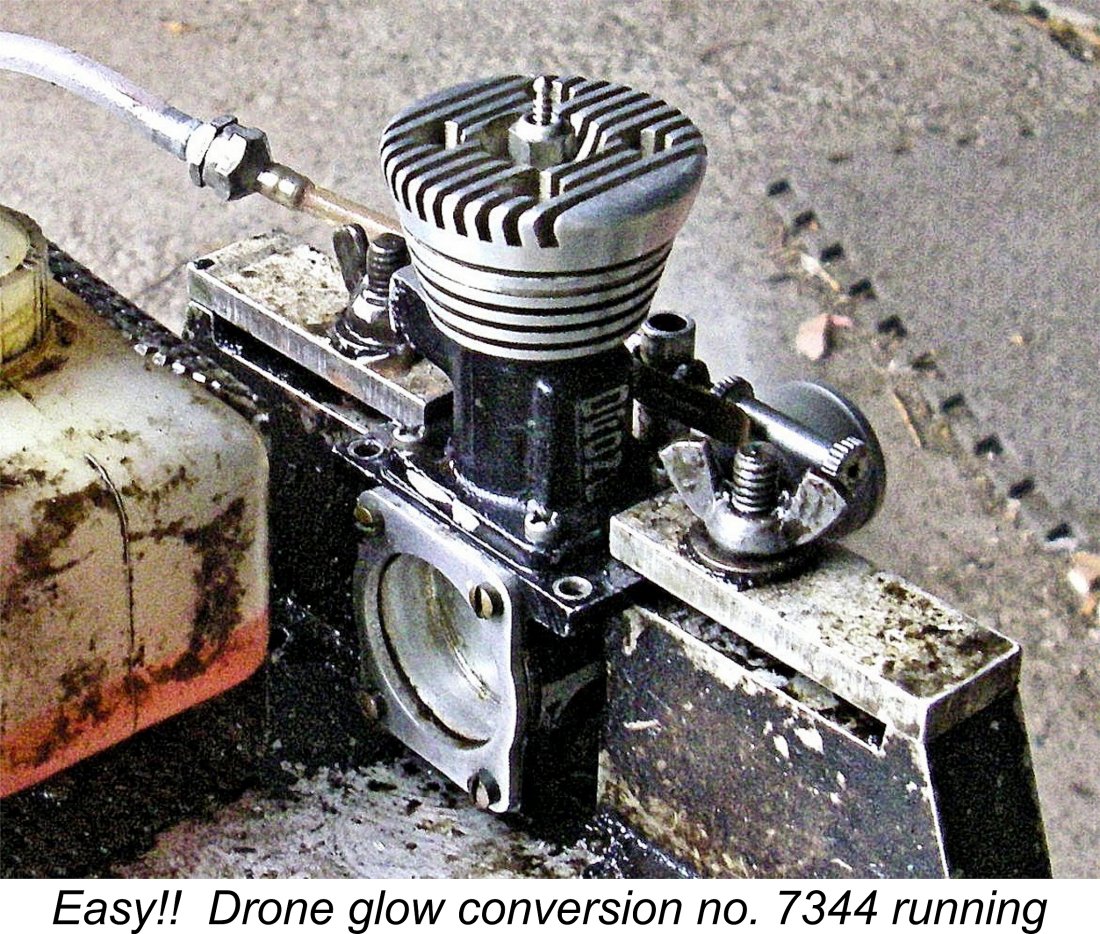 When operated as a fixed compression diesel with an all-ether fuel, the needle setting for starting is generally somewhere around 2 turns open with the standard Drone needle valve assembly. With a methanol fuel, the engine would undoubtedly require a far more wide-open needle setting. I set the needle at 5 turns open, which proved to be a pretty good guess.
When operated as a fixed compression diesel with an all-ether fuel, the needle setting for starting is generally somewhere around 2 turns open with the standard Drone needle valve assembly. With a methanol fuel, the engine would undoubtedly require a far more wide-open needle setting. I set the needle at 5 turns open, which proved to be a pretty good guess. 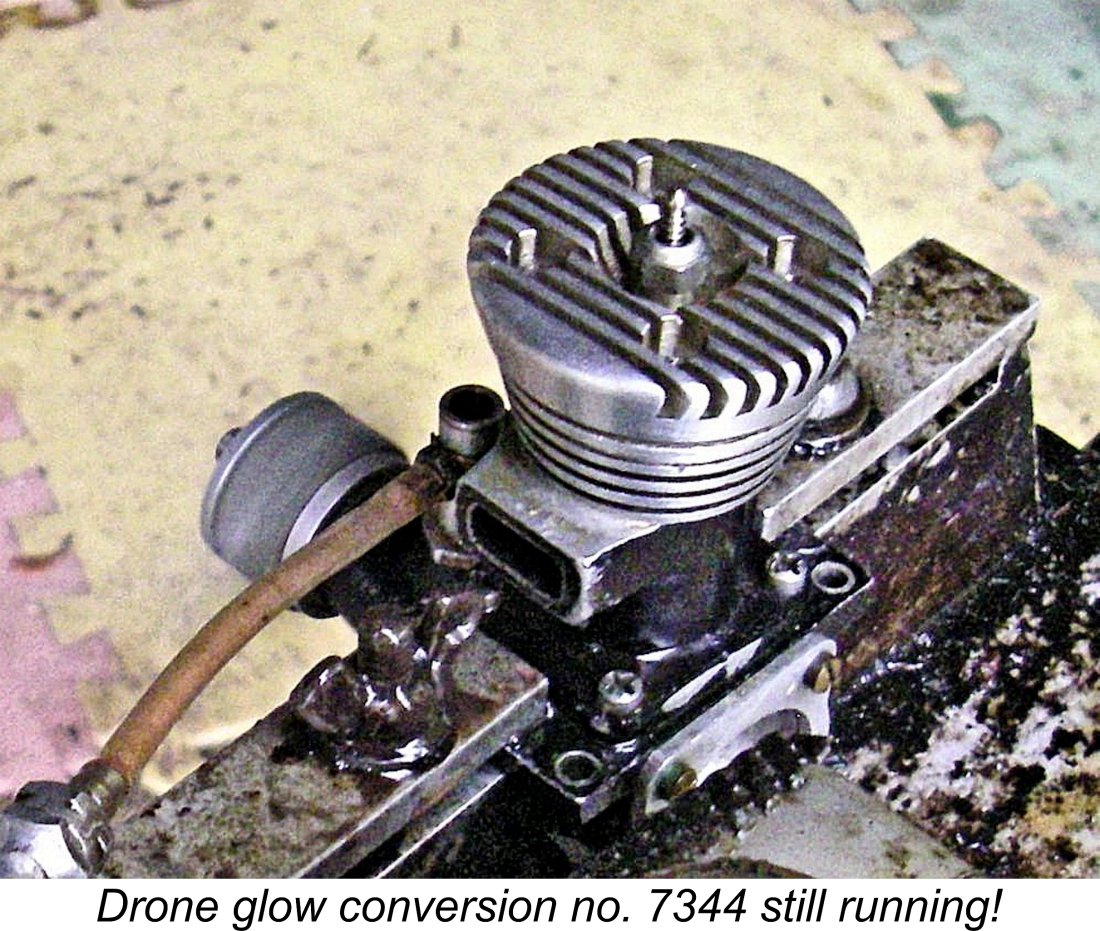 So far it's all good news, right? Well, now things go downhill a little! I was quite discouraged to find that the glow-plug Drone could only manage 6,800 rpm on the APC 10x6 with which I got things rolling. The fixed-compression diesel version which I had tested previously managed 7,800 rpm on that same prop despite being under-compressed at that speed. I tried switching to a 10x4 APC to see if the glow-plug ignition needed a higher speed to work at its best, but the engine only managed 7,000 rpm on this far lighter load, with vibration levels becoming increasingly problematic. It seemed to be already on the downward side of the peak.
So far it's all good news, right? Well, now things go downhill a little! I was quite discouraged to find that the glow-plug Drone could only manage 6,800 rpm on the APC 10x6 with which I got things rolling. The fixed-compression diesel version which I had tested previously managed 7,800 rpm on that same prop despite being under-compressed at that speed. I tried switching to a 10x4 APC to see if the glow-plug ignition needed a higher speed to work at its best, but the engine only managed 7,000 rpm on this far lighter load, with vibration levels becoming increasingly problematic. It seemed to be already on the downward side of the peak. 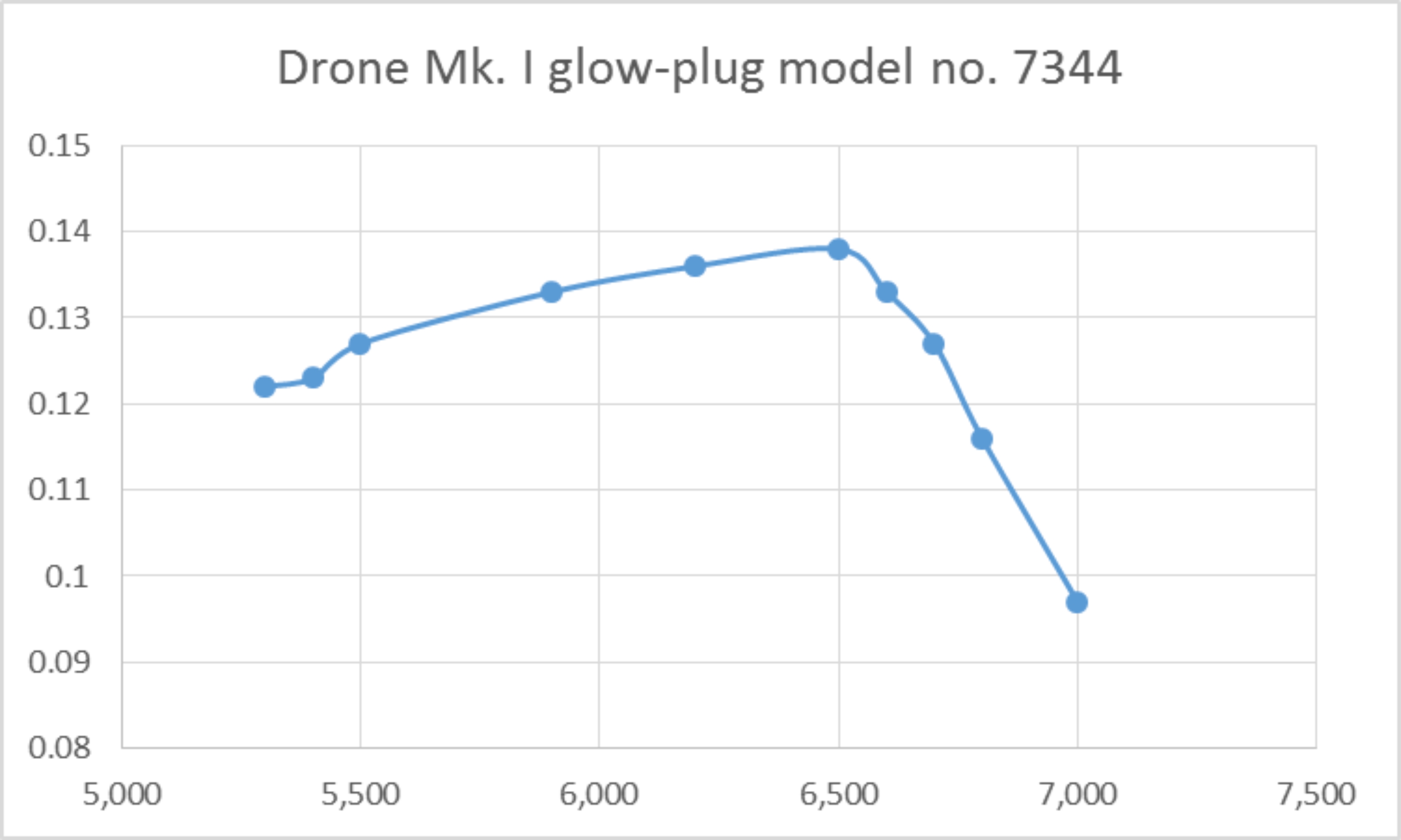
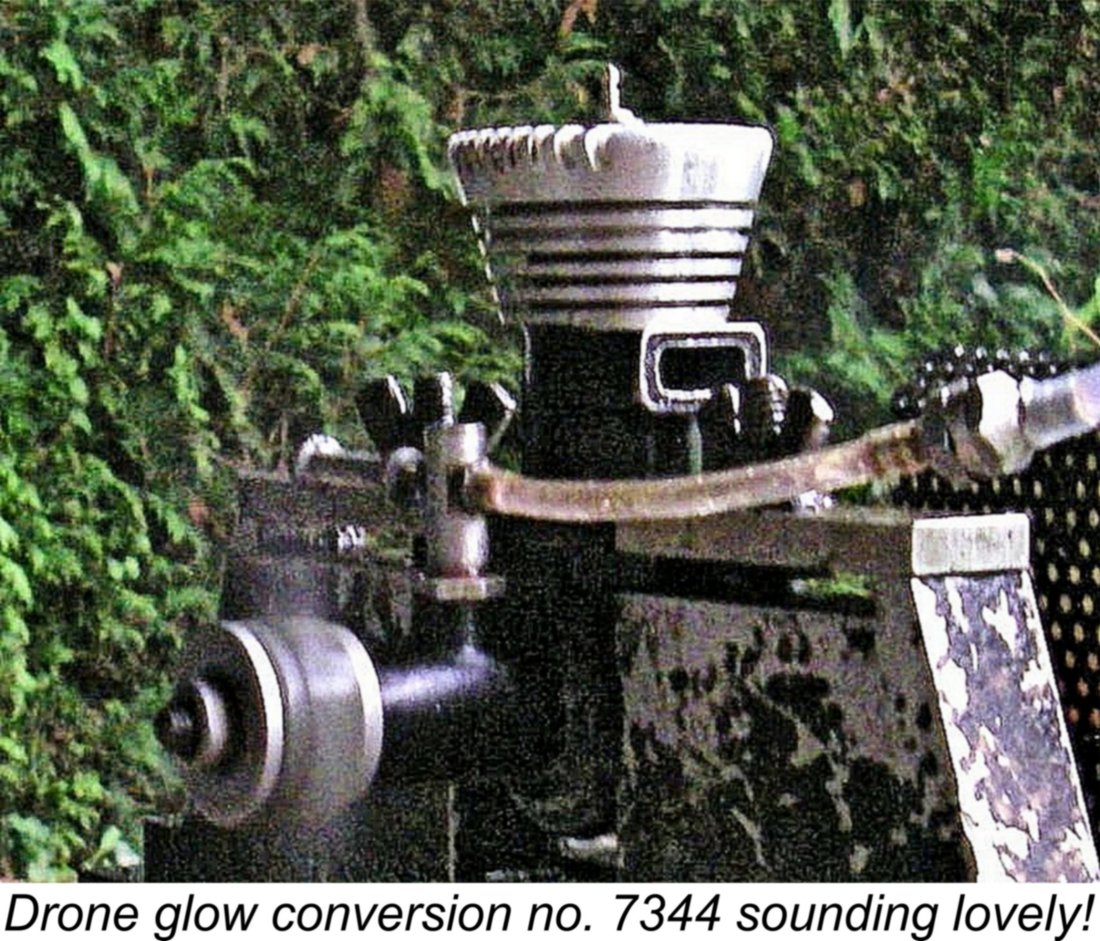 In my opinion, this result is best explained by objective consideration of the Drone glow head's extremely inefficient combustion chamber. It has two major strikes against it. Firstly, that annular channel surrounding the business end of the glow-plug will eliminate any suggestion of mixing turbulence in the combustion chamber, actually encouraging dispersion of mixture rather than concentration. Secondly, the step in the piston crown on the transfer side will in effect create an isolated pocket of mixture at the outer edge of the combustion chamber at top dead centre, tucked well away from the point ignition source.
In my opinion, this result is best explained by objective consideration of the Drone glow head's extremely inefficient combustion chamber. It has two major strikes against it. Firstly, that annular channel surrounding the business end of the glow-plug will eliminate any suggestion of mixing turbulence in the combustion chamber, actually encouraging dispersion of mixture rather than concentration. Secondly, the step in the piston crown on the transfer side will in effect create an isolated pocket of mixture at the outer edge of the combustion chamber at top dead centre, tucked well away from the point ignition source. 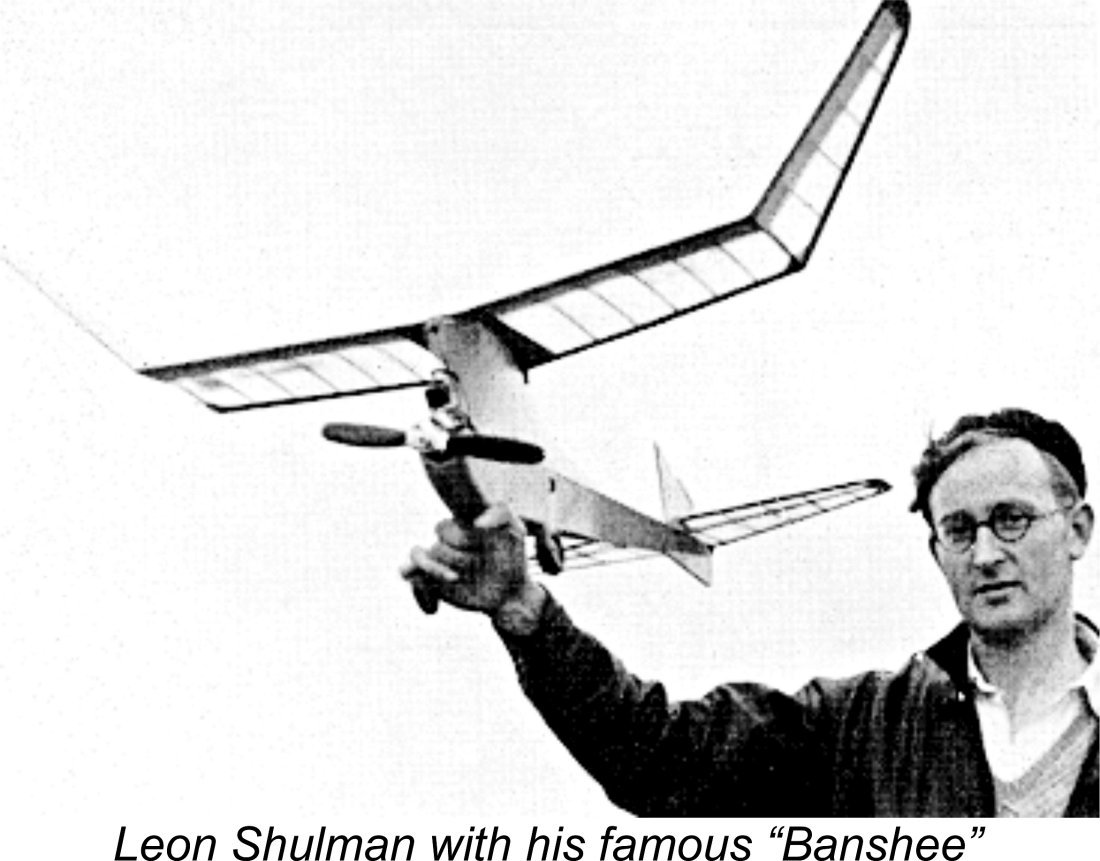 I hope that you've enjoyed this look back at a rearguard action fought by a modeller and model engine manufacturer of great distinction, ability and integrity - Leon Shulman. The glow-plug conversion kit for the Mk. I Drone was a logical idea which undoubtedly seemed to offer a pathway towards extending the working lives of those engines. However, it was grafted as an afterthought onto an engine which had been designed for operation in an entirely different mode. Consequently, the levels of performance achieved pretty much guaranteed that the results in sales terms would be somewhat less than spectacular.
I hope that you've enjoyed this look back at a rearguard action fought by a modeller and model engine manufacturer of great distinction, ability and integrity - Leon Shulman. The glow-plug conversion kit for the Mk. I Drone was a logical idea which undoubtedly seemed to offer a pathway towards extending the working lives of those engines. However, it was grafted as an afterthought onto an engine which had been designed for operation in an entirely different mode. Consequently, the levels of performance achieved pretty much guaranteed that the results in sales terms would be somewhat less than spectacular.